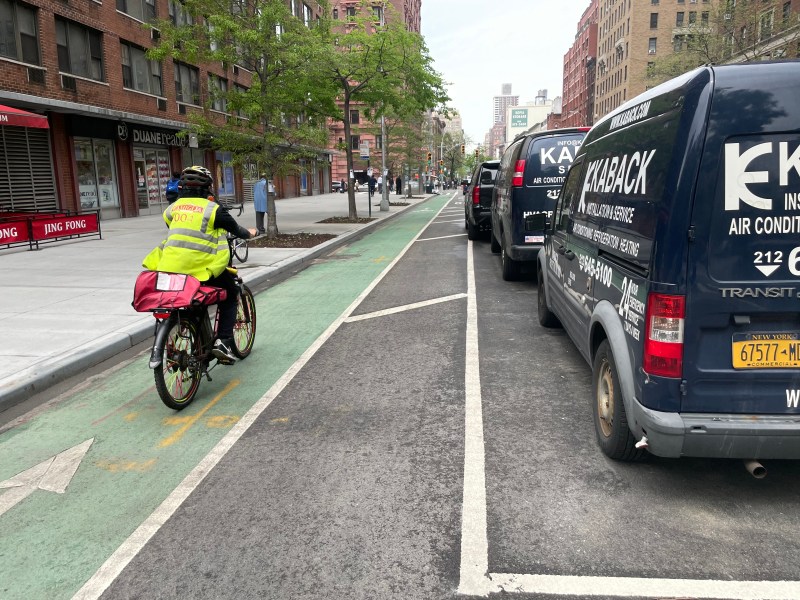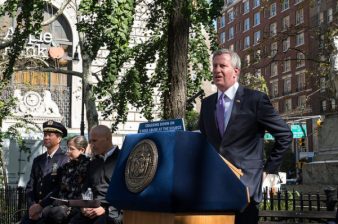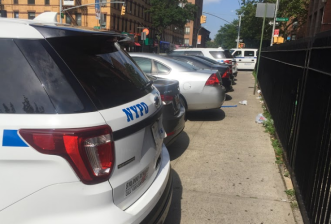NYPD: E-Cyclist Struck and Killed Elderly Man Stepping into UWS Bike Lane Between Cars

An elderly man has died after police say he was struck by an electric bike rider in the protected bike lane on Amsterdam Avenue earlier this month — highlighting a lack of safe infrastructure and a culture that caters more to vehicles than the safety of pedestrians and cyclists.
Cops offered limited information, but said that on April 17 at about 1:30 p.m., a 39-year-old e-biker, whose name was not released, was heading north in the green paint near W. 78th Street when he hit 71-year-old Hing Chung of Bensonhurst. Chung was rushed to St. Luke’s Hospital, where he died on April 25.
Police said Chung had “stepped out in between two vehicles” to cross Amsterdam Avenue from east to west about 60 feet north of W. 78th Street. The biker remained on the scene, according to police, who say the NYPD’s Highway District’s Collision Investigation Squad is investigating.
Cops could not say how fast the e-biker was going when he knocked Chung to the ground, but locals have long complained about their speed and recklessness — even though data show e-bikers, most of whom are low-income immigrant delivery workers, caused less than one percent of all motor vehicles injuries in 2018, Streetsblog reported.
But what exactly preceded the crash is not clear. The northbound bike lane is protected bike a row of parked cars on the west side of Amsterdam Avenue where cops say Chung was hit, but it’s not known if Chung had crossed all the way from the other side of the street and then emerged from between parked cars, or if he had just parked his car and stepped into the bike lane as he tried to get to the sidewalk.
What is clear though, is the need to build streets that, by design, limit the potentially dangerous interactions between cars, cyclists, and pedestrians, like the one that killed Chung, according to a safe streets advocate.
“We need to think about the designs of major avenues and how restaurants can safely operate and how bikers still use the bike lane without worrying about people walking in front all the time,” Streetopia UWS Director Lisa Orman said. “People don’t typically walk through moving vehicle lanes and expect people to break immediately, bike lanes are moving lanes for bikers and not really respected.”
Orman also acknowledged that some e-bikers do “travel way too fast.” (Cyclists, like drivers, are subject to speed limit restrictions. On that stretch of Amsterdam Avenue, the speed limit is 25 miles per hour. Cops did not indicate if the cyclist who hit Chung was given a speeding ticket, but that option, plus failure to exercise due care, was obviously available to the officers.)
But it’s not just e-bikers that are an issue. The crash that killed Chung was the second in just three days at the same intersection — on April 20, a taxi driver struck a cyclist, according to the vigilante app Citizen. A photo taken there that day captures how the city puts the lives of car drivers above pedestrians and cyclists — construction work blocked off the sidewalk, forcing a pedestrian into the bike lane.
Give me an example, without using words, of how much of NYC values personal vehicle storage over the safety of pedestrians and cyclists. I’ll start:
.
.#BikeNYC @StreetsblogNYC @NYCBikeLanes pic.twitter.com/p35Y73QXja— gconnelie (@GCONNELIE) April 20, 2021
Last year, there were 46 reported crashes on just the 10 blocks of Amsterdam Avenue between W. 72nd and 81st streets, causing 13 injuries, including to five cyclists, four pedestrians and four motorists, according to Crash Mapper.
Last year in the entire city, e-bikers killed one pedestrian, while during the same time, drivers killed 85 pedestrians and at least 22 cyclists, according to Crash Mapper.
The Department of Transportation did not respond to a request for comment.
It is common after the rare instances that a cyclist kills a pedestrian for driver advocates to use the story to decry the city’s reckless streets supposedly filled with rogue cyclists — and to demand fewer bike lanes. But such revanchism would only make the city less safe, not more safe, as roadways with proper infrastructure for cyclists and drivers have proven over time to make the city safer.
As Streetsblog recently reported, Manhattan avenues with even cursory safety improvements provide better safety than the avenues totally devoted to car travel. First Avenue between 34th and 42nd streets, which has a parking-protected bike lane and a single bus lane among its six lanes, had 78 reported crashes in 2019, injuring just six pedestrians and no cyclists. On the corresponding stretch of Third Avenue, however, there were 180 reported crashes in 2019, injuring five cyclists and five pedestrians (one pedestrian was killed).

